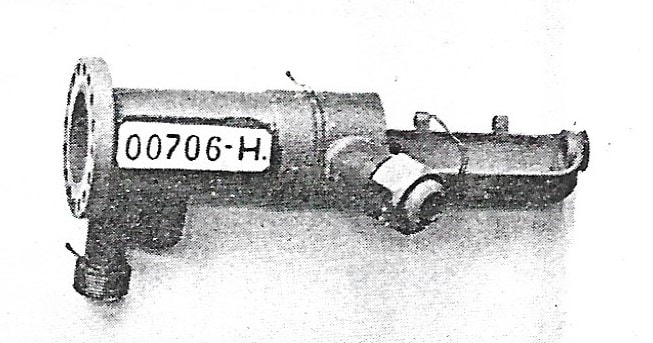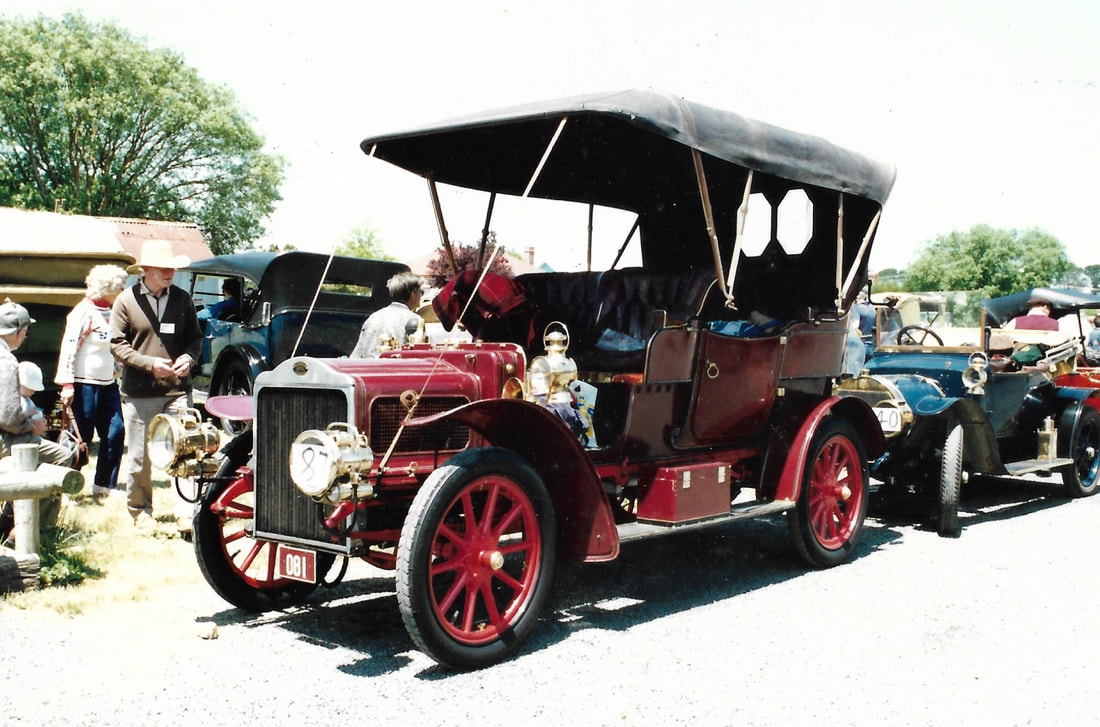White Technicalities Issue 35/2/2021 July, 1983 Covered in this article- Dick Hempel’s Steam Car Background, a simple check list of the White “New Regulation” System. Dear Friend: In 1946 I was 26 years old and lived in Kansas City when I bought my first White Steam Car, a 1909 touring, model “O”. I found it in a barn on a farm just outside Humboldt, Kansas. It has not run in years but was remarkably complete including all brass lamps, tools, top, etc. I had to pay $450.00 which was then twice my monthly salary, and a lot of money in those days. My dear dad and all my neighbours thought I was daft. Even before that I had owned a 1901 Locomobile and a 1917 Model 725 Stanley. In 1950 I bought my first Doble. I was then 30 years old, and had also owned numerous internal combustion antique cars. In 1949 I had organised the first official antique car tour ever held west of the Mississippi (except California). It was called “Run to Cameron” (Missouri). I took two steamers on that event and both ran fine. The 1901 Loco and the 1909 White. A friend who had never before operated a steamer, ran the Loco. I kept shouting instructions to him along the way, but he was scared to death the entire route. In those days the Horseless Carriage Club was a idy biddy outfit in far off California. I had no one in my area to advise me and few to write to. Roland Giroux (now sadly deceased) of Reno, Nevada helped me some by answering my questions, but he too was far, far away. At one Kansas City HCCA meeting held at my home in Kansas City, 1950, I had all four makes of famous steam autos running at the same time. Locomobile, Stanley, Doble, and White. So far as is known, no one has ever done this since. One of the 1909 White 0'S which Dick Hempel Restored- photo courtesy of https://www.pinterest.co.uk/pin/258464466091904732/ Doble e20, which was restored and owned by Dick Hempel- photo courtesy of photo courtesy of https://www.pinterest.co.uk/pin/258464466091904732/ The first car ever to ascend Pike’s Peak was a 1901 Locomobile just like mine. When I learned the 50th anniversary of this event was going to be re-created, I took my car out and climbed the mountain with a friend, Sam Arnholz, doing the driving. Since then, many antique car clubs have copied what I did. Since those days I have gone on to purchase another Doble, two more model “O” Whites, a 1909 model “M” White, a 1926 SV Stanley, a 1909 20HP model “R” Stanley, and now, the 1908 model “K” White. I did not have much of an education…but am self-educated. Travelling all over the world as a TWA Captain helped a great deal. And, owning eleven steam cars has taught me a little something about them! Trouble is, just because I have owned and operated so many steamers, some people get the idea I am a “Steam Car Expert”. Well, for their information I never thought of myself as an expert by any means. On the other hand, wouldn’t I be rather stupid if I had not learned a little something about steamers along the way? After having burned my fingers so many times and making as many mistakes as I have, whatever level of knowledge I possess comes from raw experience. Kind of like the hill billy who had eighteen kids before he was forty years old. When they asked him whether or not he considered himself a good father, he replied: “I’m still learnin’”. My background training in systems & controls and later, in computers, was provided over the years in various TWA pilot training seminars. Plus, some highly complicated ground school classes. This in turn helped me to understand how steam car regulating systems should work. And, having owned so many of the critters, driven them as much as I have, (I have just ordered a third set of tyres for the Doble), I am a fairly good shade tree mechanic. The White Steam Cars after 1906 had a different control system (with Flowmotor) and this system was referred to by the company as “New Regulation”. Doble Steam Motors Corp. took this system and improved upon it. Were I to add up all the hours of study I have spent in researching these two systems, I could have been a brain surgeon! What’s more, when it comes to White, I seem to be just like the hill billy-I’m still learnin’! Just last Saturday a thing happened I had never encountered previously. I was amazed… All of this brings me around to the point of this letter. Sometimes guys write asking for my advice. I take time to sit down and give it as best I can. When I later find out their White does not run well because my advice was not heeded, it bothers me. You chaps don’t always listen so good- go right ahead doing all the wrong things or, do not do the right things. If you are not going to follow my recommendations, then why waste my time and your time by asking for my advice? If you are going to modernise, improve, innovate, and alter your White, then it is impossible for me to be of any help at all! The reason I cannot help when you modify your White is quite easy to see. My fund of White knowledge lies solely within the scope of factory specifications. I do understand those specs. But when you alter components the White Company engineered so very carefully and with great precision, you throw into the system new factors and thus, create problems which neither I nor anyone else can diagnose. Point is, the “New Regulation” has more than enough variables to deal with without complicating matters by adding to them. I say again (and I don’t mean to sound like a smart-Aleck), if you want to alter your White, then don’t write asking for my advice. Having said this, let me tell you that back in 1946 when I got that first model “O”, it took me three years to get the regulating system working properly. Once I succeeded, I shouted for joy. I felt like the first chap who climbed Mt. Everest. Several times I became so discouraged I nearly gave up. When I finally hit upon the right combination, I could scarcely believe my eyes. The steam temperature gauge needle stuck at the 12 o’clock position as if it was welded there, with very small, normal excursions. And it has been the same with every White I have owned. Although I will say the model “M” presented a few new problems-behaviours I had never encountered before. Here are a few suggestions-some things to check:
The White, therefore, will tolerate absolutely no water leaks nor check valve leaks. Leaky water pump glands, safety valve, throttle, water cushion, etc., cause temperature variation.
The book says to run the fuel stem up snug, then turn it “five more turns”. I have had a couple of cars where I had to run it up six or more turns to account for an old, weak spring. In summation, I have always said that a White Steam Car will make an utterly honest man out of it’s owner. It will not tolerate any sort of modification. The White Company engineering was truly marvellous, considering it was done back in the blacksmith era. Burner nozzle hole size, the grind on the Flowmotor fuel pin, the lift on the balls in the check valves, water pump plunger diameter, lift of the Finnegan Pin, size of the Finnegan Pin hole, taper on the thermostat water valve pin and the diameter of the hole it fits into, the depth of the channel in the cylinder wall of the Flowmotor and its relationship with the piston, total length of the passages inside the fuel vapouriser for the type of fuel being used (White made several different vapourisers) , diameter of hole in the Flowmotor water bypass…. Any of these items not set to factory specs will upset steam temperature control. They all must be just right! And, until you get them Just Right you will never enjoy your White Steam Car. When you finally do, you will enjoy your car more than any other you have owned or driven. For the White is a totally unique machine, quite unlike any other antique car, including the Stanley. You will also have a sense of pride and of accomplishment no other antique car owner can understand, unless he too is a White owner. Lastly, you will become one of a select few people on this earth. To date, there are fewer than six men operating a White successfully, day in and day out. We lost one of the great ones when A.B. McInnes of Australia died. If any man could make a White run, it was purely he. Drove his “O” regularly, even to work, plus thousands of miles of touring. On one tour he broke the water pump drive arm, stayed up all night, removed the arm without removing the engine (try it sometime!), welded the arm, put it back in the engine just as the sun rose and in time for that day’s tour! Some kind of a guy McInnes was-truly an expert.
0 Comments
Leave a Reply. |
Archives
June 2021
Categories |
|
|
Steam Car Network functions as a resource for all steam car and steam bike enthusiasts. The website is constantly updated with articles, events, and informative posts to keep the community alive and growing. Feel free to contact us if you have any questions or concerns at the email address below and we will promptly reply.
[email protected] |


 RSS Feed
RSS Feed
